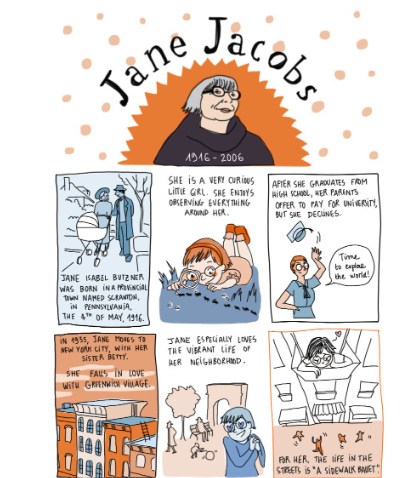Places Briefing #6
Jane's walk cities, Age-inclusive cities, civil engagement, and calls for papers on proximity planning and the 15-minute city, neighbourhoods and social capital and nature-based solutions.
The Places Briefing series from Policies for Places aims to alert readers to recent reports, events and opportunities relevant to building better places, and when possible, to supplement longer pieces which have been published in Policies for Places.
Jane’s Walks - Celebrating Jane Jacobs
Every year during the first weekend of May, cities around the world host "Jane's Walks": community-led walking tours that spark civic dialogue and amplify voices often left out of urban conversations.
You can check if a city near you hosts a Jane's Walk here.
I came across a wonderful illustrated life of Jane Jacobs of which the image below is an excerpt.
The full illustrated story is by French artist Penelope Bagieu and can be found on the Urban Mycelium blog.
See her whole illustrated story here.
Age-inclusive cities
The OECD Centre for Entrepreneurship, SMEs, Regions & Cities has released an new report addressing one of urban planning's most pressing challenges: creating cities that work for residents of all ages. The report outlines how inadequate urban design, insufficient housing options, and limited employment opportunities create significant social and economic costs across demographic groups.
The report shows that age-inclusive planning enhances urban quality, climate resilience, and digital inclusion across communities. For example, the report points to the benefits from reskilling older adults to help address labor shortages, and investment in pedestrian safety to reduce emissions and health-related costs.
The report also highlights the consequences of inaction. Spatial and economic inequalities affect living conditions and access to services for both younger and older city dwellers. The lack of suitable and affordable housing options, combined with inaccessible public transportation, presents major challenges to creating truly inclusive cities. Exclusionary urban design also results in missed economic opportunities in sectors serving both older and younger residents.
To address these challenges, the report presents a structured checklist of nine key actions that governments at all levels can implement to create age-inclusive cities.
Find more about the report here.
Calls for Papers
For those with an interest in Proximity Planning or the 15-minute city, these calls for journal papers for journal special editions caught my eye.


Full details, including topics to be featured and submission dates, of the special issue of the Journal of Urban Mobility can be found here and for the Journal of Urbanism special edition here.
Civil Engagement
For those with an interest in more rural areas, this is a report of a study in the US which explores the perspectives and experiences of some 500 people resident in 8 rural areas about who and what builds trust, agency and belonging in rural communities. The findings highlight that across all communities, local trust was high but national trust was low, that taking action together was a strong driver of trust, agency and belonging, and that informal civic engagement impacted these factors just as much as involvement in formal opportunities.
It would be interesting to see how well these findings transfer to urban settings and practice in community development.
Nature-based solutions
Here is a fun guide to possibilities for nature-based solutions in cities from UN-Habitat.
Perfect for workshops or prompting creativity and innovation.
Neighbourhoods of the future
Not a new report, but nevertheless still very worth reading. This ‘Whitepaper’ from Hoplr proposes a formula for understanding and developing neighborhood social capital: POTENTIAL × ACCESS = SOCIAL CAPITAL. This framework provides a basis for analyzing how communities function and can be strengthened through deliberate interventions.
Taking an asset-based community development approach the paper offers practical methodologies and a catalogue of programmes for action from creating quality public spaces to implementing digital neighborhood networks for building social capital and revitalized neighbourhoods.
You can access the report here.
———oo0oo ———
You might be interested to read some related papers on Policies for Places.:
‘Nearness’ and social cohesion








